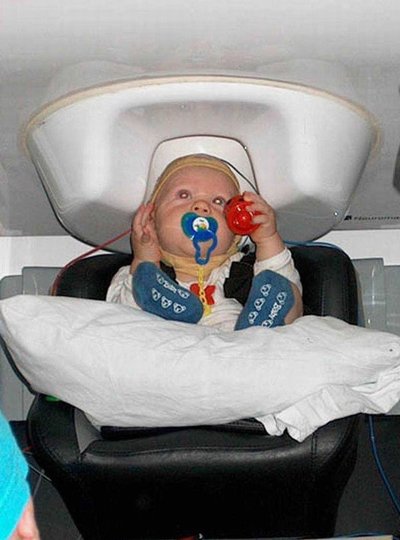July 10, 2006
Practice builds brain connections for babies learning language, how to speak
Experience, as the old saying goes, is the best teacher. And experience seems to play an important early role in how infants learn to understand and produce language.
Using new technology that measures the magnetic field generated by the activation of neurons in the brain, researchers tracked what appears to be a link between the listening and speaking areas of the brain in newborn, 6-month-old and one-year-old infants, before infants can speak.
The study, which appears in this month’s issue of the journal NeuroReport, shows that Broca’s area, located in the front of the left hemisphere of the brain, is gradually activated during an infant’s initial year of life, according to Toshiaki Imada, lead author of the paper and a research professor at the University of Washington’s Institute for Brain and Learning Sciences.
Broca’s area has long been identified as the seat of speech production and, more recently, as that of social cognition and is critical to language and reading, according to Patricia Kuhl, co-author of the study and co-director of the UW’s Institute for Brain and Learning Sciences.
“Magnetoencephalography is perfectly non-invasive and measures the magnetic field generated by neurons in the brain responding to sensory information that then ‘leaks’ through the skull,” said Imada, one of the world’s experts in the uses of magnetoencephalography to study the brain.
Kuhl said there is a long history of a link in the adult brain between the areas responsible for understanding and those responsible for speaking language. The link allows children to mimic the speech patterns they hear when they are very young. That’s why people from Brooklyn speak “Brooklynese,” she said.
“We think the connection between perception and production of speech gets formed by experience, and we are trying to determine when and how babies do it,” said Kuhl, who also is a professor of speech and hearing sciences.
The study involved 43 infants in Finland — 18 newborns, 17 6-month-olds and 8 one-year olds. Special hardware and software developed for this study allowed the infants’ brain activity to be monitored even if they moved and captured brain activation with millisecond precision.
The babies were exposed to three kinds of sounds through earphones — pure tones that do not resemble speech like notes played on a piano, a three-tone harmonic chord that resembles speech and two Finnish syllables, “pa” and “ta.” The researchers collected magnetic data only from the left hemisphere of the brain among the newborns because they cannot sit up and the magnetoencephalography cap was too big to securely fit their heads.
At all three ages the infants showed activation in the temporal part of the brain, Broca’s area, that is responsible for listening and understanding speech, showing they were able to detect sound changes for all three stimuli. But the pure perception of sound did not activate the areas of the brain responsible for speaking. However, researchers began seeing some activation in Broca’s area when the 6-month-old infants heard the syllables or harmonic chords. By the time the infants were one-year old, the speech stimuli activated Broca’s area simultaneously with the auditory areas, indicating “cross-talk” between the area of the brain that hears language and the area that produces language, according to Kuhl.
“We think that early in development babies need to play with sounds, just as they play with their hands. And that helps them map relationships between sounds with the movements of their mouth and tongue,” she said. “To master a skill, babies have to play and practice just as they later will in learning how to throw a baseball or ride a bike. Babies form brain connections by listening to themselves and linking what they hear to what they did to cause the sounds. Eventually they will use this skill to mimic speakers in their environments.”
This playing with language starts, Kuhl said, when babies begin cooing around 12 weeks of age and begin babbling around seven months of age.
“They are cooing and babbling before they know how to link their mouth and tongue movements. This brain connection between perception and production requires experience,” she said.
Co-authors of the study were Yang Zhang of the University of Minnesota, Marie Cheour of the University of Miami and Helsinki University Central Hospital, and Samu Taulu and Antti Ahonen of Elekta Neuromag Oy in Findland. The National Institutes of Health, the National Science Foundation, the Talaris Research Institute and the Apex Foundation, the family foundation of Bruce and Jolene McCaw, supported the research.
###
For more information, contact Kuhl at (206) 685-1921 or pkkuhl@u.washington.edu or Imada at (206) 543-4541 or imada@u.washington.edu



